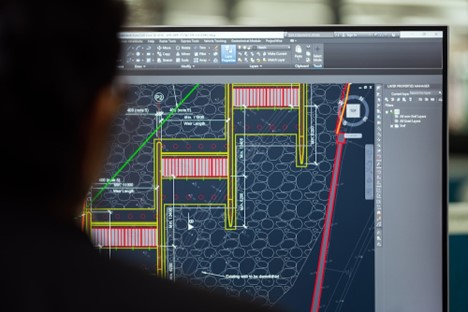“Change does not roll in on the wheels of inevitability, but comes through continuous struggle.“ -Martin Luther King, Jr.
Many events and activities in life require planning, like saving up for a vacation or setting aside time to catch up with friends and colleagues. Industrial processes are no different. Blueprints, technical manuals, and procedures lay a detailed path to keep a process running. One of many essential pieces of documentation are Piping and Instrument Diagrams (P&IDs), which lay out the equipment and accessories of a plant and serve as a resource for safety programs. The PSM standard requires that these are current by stating that P&IDs are updated when there is a significant change to the process. How that is interpreted by OSHA inspectors and the engineers in the field can differ vastly.
P&IDs Origins
P&IDs get their start during the early stages of process design. Their precursor, Process Flow Diagrams (PFDs), are created to take a process description and split it into individual parts that mark a certain step in the process (e.g., a reaction, distillation, absorption, etc.). This includes general process equipment for each step and how they connect.
P&IDs take these steps of the process and specify the equipment and accessories the plant will have installed that will encompass the process. They may also contain process vessel specifications, control layouts (Safety Instrumented Functions and Distributed Control System loops), and some information about facility siting (vessels above or at grade, lines underground, etc.). These documents are used by engineers as a reference for improvement projects and by operators to get familiarity during training and to run the process. P&IDs are indispensable in chemical industries as they portray areas where safety hazards exist and the means to reduce the risk and likelihood of a potential event.

Photo Credit: Daniel McCullough via Unsplash
Process Safety Information
P&IDs become part of a plant’s Process Safety Information (PSI) when they are part of a covered process as described in OSHA’s Process Safety Management Standard (29 CFR 1910.119) or EPA’s Risk Management Program (40 CFR 68). Both require safety information to be maintained. More specifically, the PSM standard requires that PSI are a current representation of a process (29 CFR 1910.119(l)(4)). This part of the standard states that “If a change covered by [the process] results in a change in the process safety information required by paragraph (d) [the process safety information subsection], such information shall be updated accordingly.” Subsection (l) refers to the Management of Change requirement of the PSM standard and is the process that governs how changes in a process are made.
When are updates required?
According to the PSM Standard, a Management of Change (MoC) procedure is required to manage changes to the process, whether chemical, technology, equipment, or procedural. A MoC is a procedure by which most chemical plants consider changes that are associated when process design is adjusted. During the life of a plant, changes range from replacements in kind (which don’t require a MoC) to significant revisions (major equipment upgrades, catalyst changes). When a change occurs in a covered process that is subject to the MoC procedure, it can change the process safety information, including P&IDs. The extent of changes to a P&ID can be as small as updating the Maximum Allowable Working Pressure (MAWP) of a vessel after rerating. Regardless, the change to the P&ID needs to be made so that the MoC can be closed out. Not surprisingly, MoCs happen frequently enough that multiple changes may be required to sets of P&IDs, but there are times when updates to the process occur that involve no change to the PSI. If these MoCs are required to consider updates to PSI, and more particularly P&IDs, forgoing changes could be dire.
Where P&IDs come to Rest
P&IDs are used in many places of the Safety Life Cycle. A common appearance can be found in Process Hazard Analysis (PHAs), where P&IDs are the basis of node structure or at least of establishing the boundaries of what is PSM-covered. P&IDs that match the current process are ideal for these scenarios, as the facilitator and team can refer to them without calling into question areas where there is uncertainty. When uncertainty occurs, it leads to referring to others outside the team, which delays the continuation of the PHA. Control schematics and major equipment specifications that don’t match what is installed can lead to errors and assumptions where the incorrect risk reduction is assigned. These mistakes may not lead to anything significant, but they may increase the likelihood of hazardous events.
Let’s use the simple example of rerating the MAWP of a vessel. If it is an increase, the set points of control valves on inputs and outputs could be updated in the control narrative to accommodate a higher operating pressure. This adjustment of set points may not consider the vessel’s relief devices, as not all can be adjusted easily, and all normally require testing to confirm that they can account for a higher relief discharge pressure. If ignored this can result in chattering of the device that lessens its effectiveness for a major release, as most valves are designed to relieve once and may seat correctly after a release. Or worse, result in a premature release that runs from a loss in production to a hazardous area at the vent discharge.
Continual Improvement
There are few items regarding PSI that have specified timeframes listed in the PSM standard and the RMP rule. P&IDs are not among them. When MoCs are not prompting changes, it still behooves a team familiar with the drawings to review and implement updates. This includes utilities and related equipment, even if not within the boundaries of a covered process. Utilities can still result in changes to the process conditions.
Some facilities have decided to develop a P&ID document review cycle to catch these deficiencies, and to their credit, these periodic reviews help. The roles of facilitating and consulting on the Safety Lifecycle become easier when the information is accessible and current. There is less waiting for specifications to be found in PHAs and it also helps in reviewing material during PSM compliance audits. The duration between reviews can vary based on factors like the complexity of the process (e.g., number of P&IDs), hazardous areas, and the availability of the team for review. The review period does not need to exist within a certain range, but having a period ensures that if a change is forgotten on a MoC, the update doesn’t drop off into obscurity.
The Circle of Process Life
When it comes to keeping information current, there is only so much that can be done through administrative controls. While a good documentation process can ensure that Process Safety Information like P&IDs are accurate initially, it will depend on the individuals who change and update the facility to mark and push to have the necessary pieces updated. Some groups may be better than others, but by having the right protocols and procedures in place, any new change has the potential to trigger a second look at the P&IDs and the safeguards in place to ensure everyone can return home. Try to take this into account when reviewing P&IDs and if the revision date is more than a few years old, it may be best to take a second look.
